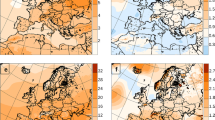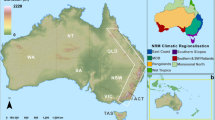Abstract
This study used “factor separation” to quantify the sensitivity of simulated present and future surface temperatures and precipitation to alternative regional climate model physics components. The method enables a quantitative isolation of the effects of using each physical component as well as the combined effect of two or more components. Simulation results are presented from eight versions of the Mesoscale Modeling System Version 5 (MM5), one-way nested within one version of the Goddard Institute for Space Studies Atmosphere-Ocean Global Climate Model (GISS AOGCM). The MM5 simulations were made at 108 km grid spacing over the continental United States for five summers in the 1990s and 2050s. Results show that the choice of cumulus convection parameterization is the most important “factor” in the simulation of contemporary surface summer temperatures and precipitation over both the western and eastern USA. The choice of boundary layer scheme and radiation package also increases the range of model simulation results. Moreover, the alternative configurations give quite different results for surface temperature and precipitation in the 2050s. For example, simulated 2050s surface temperatures by the scheme with the coolest 1990s surface temperatures are comparable to 1990s temperatures produced by other schemes. The study analyzes the spatial distribution of 1990s to 2050s projected changes in the surface temperature for the eight MM5 versions. The predicted surface temperature change at a given grid point, averaged over all eight model configurations, is generally about twice the standard deviation of the eight predicted changes, indicating relative consensus among the different model projections. Factor separation analysis indicates that the choice of cumulus parameterization is the most important modeling factor amongst the three tested contributing to the computed 1990s to 2050s surface temperature change, although enhanced warming over many areas is also attributable to synergistic effects of changing all three model components. Simulated ensemble mean precipitation changes, however, are very small and generally smaller than the inter-model standard deviations. The MM5 versions therefore offer little consensus regarding 1990s to 2050s changes in precipitation rates.
Similar content being viewed by others
References
Bates GT, Giorgi F, Hostetler S (1993) Toward the simulation of the effects of the great lakes on regional climate. Mon Weather Rev 121:1373–1387
Bell L, Sloan L, Snyder M (2004) Regional changes in extreme climate events: a future climate scenario. J Climate 17:81–87
Bell M, Goldberg R, Hogrefe C, Kinney P, Knowlton K, Lynn B, Rosenthal J, Rosenzweig C, Patz J (2007) Climate change, ambient ozone, and health in 50 U.S. cities. Clim Change 82:61–76
Betts A (1986) A new convective adjustment scheme. Part I: observational and theoretical basis. Quart J Roy Meteor Soc 112:677–692
Betts A, Miller M (1986) A new convective adjustment scheme. Part II: single column tests using GATE wave, BOMEX, ATEX and Artic air-mass data sets. Quart J Roy Meteor Soc 112:693–709
Betts A, Miller M (1993) The Betts–Miller scheme. In: Emanuel KA, Raymond DJ (eds) The representation of cumulus convection in numerical models of the atmosphere. Am Meteorol Soc Meteor Monogr, vol 24, no 46. American Meteorological Society, Boston, MA, pp 107–121
Chen F, Co-authors (1996) Modeling of land-surface evaporation by four schemes and comparison with FIFE observations. J Geophys Res 101:7251–7268
Chen F, Dudhia J (2001a) Coupling an advanced land-surface/hydrology model with the Penn State/NCAR MM5 modeling system. Part I: model implementation and sensitivity. Mon Weather Rev 129:569–585
Chen F, Dudhia J (2001b) Coupling an advanced land-surface/hydrology model with the Penn State/NCAR MM5 modeling system. Part II: preliminary model validation. Mon Weather Rev 129:587–604
Colle B, Mass C, Westrick K (2000) MM5 precipitation verification over the Pacific Northwest during the 1997/99 cool seasons. Weather Forecast 15:730–744
Cortinas J, Stensrud D (1995) The importance of understanding mesoscale model parameterization schemes for weather forecasting. Weather Forecast 10:716–740
Darnell W, Staylor W, Ritchey N, Gupta S, Wilber A (1996) Surface radiation budget: a long-term global dataset of shortwave and longwave fluxes. EOS Transactions, Electronic Supplement. http://www.agu.org/eos_elec/95206e.html
Davies HC, Turner RE (1977) Updating prediction models by dynamical relaxation: an examination of the technique. Quart J Roy Meteor Soc 103:225–245
Dickinson R, Errico R, Giorgi F, Bates G (1989) A regional climate model for the Western United States. Clim Change 15:383–422
Diffenbaugh N, Pal J, Trapp R, Giorgi F (2005) Fine-scale processes regulate the response of extreme events to global climate change. Proc Nat’l Acad Sci U S A 102:15774–15778
Dudhia J (1993) A non-hydrostatic version of the Penn State/NCAR mesoscale model: validation tests and simulation of an Atlantic cyclone and cold front. Mon Weather Rev 121:1493–1513
Fu C, Wang S, Xiong Z, Gutowski W, Lee D-K, McGregor J, Sato Y, Kato H, Kim J-W, Suh M-S (2005) Regional climate model intercomparison project for Asia. Bull Am Meteorol Soc 86:257–266
Gao X, Pal J, Giorgi F (2006) Projected changes in mean and extreme precipitation over the Mediterranean region from a high resolution double nested RCM simulation. Geophys Res Lett 33:LO3706. doi:10.1029/2005GL024954
Giorgi F (2006) Climate change prediction. Clim Change 73:239–265
Giorgi F, Marinucci M (1996) An investigation of the sensitivity of simulated precipitation to model resolution and its implications for climate studies. Mon Weather Rev 124:148–156
Giorgi F, Marinucci M, Bates G (1993a) Development of a second-generation regional climate model (RegCM2). Part I: boundary-layer and radiative transfer processes. Mon Weather Rev 121:2794–2813
Giorgi F, Marinucci M, Bates G, De Canio G (1993b) Development of a second-generation regional climate model (RegCM2). Part II: convective processes and assimilation of lateral boundary conditions. Mon Weather Rev 121:2814–2832
Giorgi F, Brodeur C, Bates G (1994) Regional climate change scenarios over the United States produced with a nested regional climate model: spatial and seasonal characteristics. J Climate 7:375–399
Grell G (1993) Prognostic evaluation of assumptions used by cumulus parameterizations. Mon Weather Rev 121:764–787
Grell G, Kuo Y-H, Pasch R (1991) Semi-prognostic tests of cumulus parameterization schemes in the middle latitudes. Mon Weather Rev 119:5–31
Grell G, Dudhia J, Stauffer D (1994) A description of the fifth-generation Penn State/NCAR mesoscale model (MM5), NCAR Technical Note NCAR/TN-298+STR, 117 pp
Hack JJ, Boville BA, Breigleb BP, Kiehl JT, Rasch PJ, Williamson DL (1993) Description of the NCAR Community Climate Model (CCM2). NCAR Technical Note NCAR/TN-382+STR, 120 pp
Han J, Roads J (2004) U.S. Climate sensitivity simulated with the NCEP regional spectral model. Clim Change 62:115–154
Hansen J, Co-authors (2002) Climate forcings in Goddard Institute for space studies SI2000 simulations. J Geophys Res 107:4347. doi:10.1029/2001JD001143
Hogrefe C, Biswas J, Lynn B, Civerolo K, Ku J-Y, Rosenthal J, Rosenzweig C, Goldberg R, Kinney P (2004) Simulating regional-scale ozone climatology over the eastern United States: model evaluation results. Atmos Environ 38:2627–2638. doi:10.1016/j.atmosenv.2004.02.033
Hong S-Y, Pan H-L (1996) Non-local boundary layer vertical diffusion in a medium-range forecast model. Mon Weather Rev 124:2322–2339
Intergovernmental Panel on Climate Change (2000) In: Nakicenovic N (ed) Special report on emissions scenarios. Cambridge University Press, Cambridge
Jacquemin B, Noilhan J (1990) Sensitivity study and validation of a land surface parameterization using the HAPEX-MOBILHY data set. Boundary-Layer Meteorol 52:93–134
Janjic Z (1990) The step-mountain coordinate: physical package. Mon Weather Rev 118:1429–1443
Janjic Z (1994) The step-mountain Eta coordinate model: further development of the convection, viscous sublayer, and turbulent closure schemes. Mon Weather Rev 122:927–945
Knowlton K, Rosenthal J, Hogrefe C, Lynn B, Gaffin S, Goldberg R, Rosenzweig C, Civerolo K, Ku J-Y, Kinney P (2004) Assessing ozone-related health impacts under a changing climate. Environ Health Perspect 112:1557–1563
Leung L, Qian Y (2003) The sensitivity of precipitation and snowpack simulations to model resolution via nesting in regions of complex terrain. J Hydrometeorol 4:1025–1043
Leung L, Qian Y, Han J, Roads J (2003a) Intercomparison of global reanalysis and regional simulations of cold season water budgets in the Western United States. J Hydrometeorol 4:1067–1087
Leung L, Qian Y, Bian X (2003b) Hydroclimate of the Western United States based on observations and regional climate simulations of 1981–2000. Part I: seasonal statistics. J Climate 16:1892–1911
Leung L, Qian Y, Bian X, Hunt A (2003c) Hydroclimate of the Western United States based on observations and regional climate simulations of 1981–2000. Part II: mesoscale ENSO anamolies. J Climate 16:1912–1928
Leung L, Qian Y, Bian X, Washington W, Han J, Roads J (2004) Mid-century ensemble regional climate change scenarios for the Western United States. Clim Change 62:75–113
Liang X-Z, Li L, Kunkel K (2004) Regional climate model simulation of U.S. precipitation during 1982–2002. Part I: annual cycle. J Climate 17:3510–3529
Lynn B, Druyan L, Hogrefe C, Dudhia J, Rosenzweig C, Goldberg R, Rind D, Healy R, Kinney P, Rosenthal J (2004) Sensitivity of present and future surface temperatures to precipitation characteristics. Climate Res 28:53–65
Lynn B, Healy R, Druyan L (2006) An analysis of the potential for extreme temperature change based on observations and model simulatons. J Climate 20:1539–1554
Mahrt L, Ek M (1984) The influence of atmospheric stability on potential evaporation. J Climate Appl Meteor 23:222–234
Mahrt L, Pan H (1984) A two-layer model of soil hydrology. Bound-Layer Meteor 29:1–20
Mass C, Ovens D, Westrick K, Colle B (2002) Does increasing horizontal resolution produce better forecasts? The results of two years of real-time numerical weather prediction over the Pacific Northwest. Bull Am Meteorol Soc 82:407–430
Mlawer E, Taubman S, Brown P, Iacono M, Clough S (1997) Radiative transfer for inhomogeneous atmosphere: RRTM, a validated correlated-k model for the longwave. J Geophys Res 102:16663–16682
Nobre P, Moura A, Sun L (2001) Dynamical downscaling of seasonal climate prediction over Nordeste Brazil with ECHAM3 and NCEP’s regional spectral models at IRI. Bull Am Meteorol Soc 82:2787–2796
Noilhan J, Planton S (1989) A simple parameterization of land surface processes for meteorological models. Mon Weather Rev 117:536–549
Pan H-L, Mahrt L (1987) Interaction between soil hydrology and boundary-layer development. Boundary-Layer Meteorol 38:185–202
Rosenzweig C, Solecki W (Eds) (2001) Climate change and a global city: the potential consequences of climate variability and change—Metro East Coast. Report for the US Global Change Research Program, National Assessment of the Potential Consequences of Climate Variability and Change for the United States. Report. Columbia Earth Institute, Columbia University, New York, NY
Russell G, Miller J, Rind D (1995) A coupled atmosphere-ocean model for transient climate change studies. Atmos Ocean 33:683–730
Sato M, Hansen J, McCormick M, Pollack J (1993) Stratospheric aerosol optical depth, 1850–1990. J Geophys Res 98:22987–22994
Stein U, Alpert P (1993) Factor separation in numerical simulations. J Atmos Sci 50:2107–2115
Walsh K, McGregor J (1995) January and July climate simulations over the Australian region using a limited-area model. J Climate 8:2387–2403
Yang Z, Arritt R (2002) Tests of a perturbed physics ensemble approach for regional climate modeling. J Climate 15:2881–2896
Author information
Authors and Affiliations
Corresponding author
Rights and permissions
About this article
Cite this article
Lynn, B.H., Healy, R. & Druyan, L.M. Quantifying the sensitivity of simulated climate change to model configuration. Climatic Change 92, 275–298 (2009). https://doi.org/10.1007/s10584-008-9494-x
Received:
Accepted:
Published:
Issue Date:
DOI: https://doi.org/10.1007/s10584-008-9494-x




